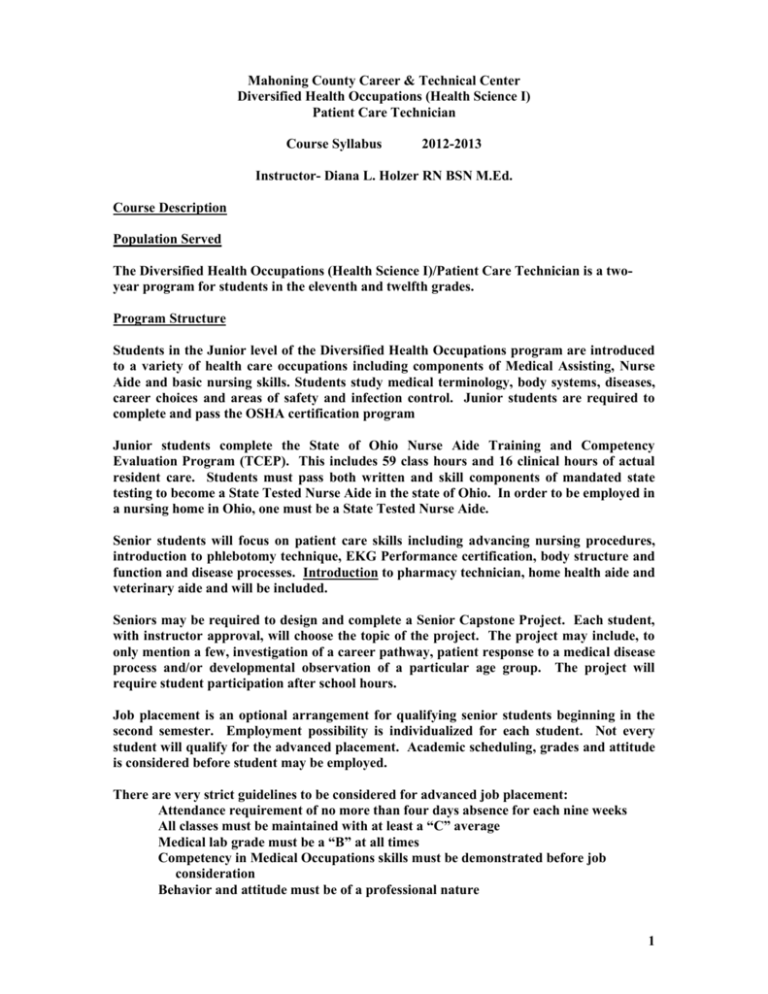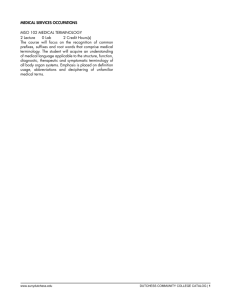File
advertisement

Mahoning County Career & Technical Center Diversified Health Occupations (Health Science I) Patient Care Technician Course Syllabus 2012-2013 Instructor- Diana L. Holzer RN BSN M.Ed. Course Description Population Served The Diversified Health Occupations (Health Science I)/Patient Care Technician is a twoyear program for students in the eleventh and twelfth grades. Program Structure Students in the Junior level of the Diversified Health Occupations program are introduced to a variety of health care occupations including components of Medical Assisting, Nurse Aide and basic nursing skills. Students study medical terminology, body systems, diseases, career choices and areas of safety and infection control. Junior students are required to complete and pass the OSHA certification program Junior students complete the State of Ohio Nurse Aide Training and Competency Evaluation Program (TCEP). This includes 59 class hours and 16 clinical hours of actual resident care. Students must pass both written and skill components of mandated state testing to become a State Tested Nurse Aide in the state of Ohio. In order to be employed in a nursing home in Ohio, one must be a State Tested Nurse Aide. Senior students will focus on patient care skills including advancing nursing procedures, introduction to phlebotomy technique, EKG Performance certification, body structure and function and disease processes. Introduction to pharmacy technician, home health aide and veterinary aide and will be included. Seniors may be required to design and complete a Senior Capstone Project. Each student, with instructor approval, will choose the topic of the project. The project may include, to only mention a few, investigation of a career pathway, patient response to a medical disease process and/or developmental observation of a particular age group. The project will require student participation after school hours. Job placement is an optional arrangement for qualifying senior students beginning in the second semester. Employment possibility is individualized for each student. Not every student will qualify for the advanced placement. Academic scheduling, grades and attitude is considered before student may be employed. There are very strict guidelines to be considered for advanced job placement: Attendance requirement of no more than four days absence for each nine weeks All classes must be maintained with at least a “C” average Medical lab grade must be a “B” at all times Competency in Medical Occupations skills must be demonstrated before job consideration Behavior and attitude must be of a professional nature 1 Failure to adhere to job placement guidelines will result in loss of the advanced placement opportunity and the student will return to the medical lab class for the remainder of the year. The grade of the student will be affected due to the inability to maintain the job. Advanced placement students will be required to maintain class assignments and skills. Junior and senior students will explore medical career options by participating in a job shadowing experience. The student will choose the site of the required experience. The host site will evaluate students. Job shadowing is a required MCCTC activity. Students successfully completing the two-year course will be able to demonstrate knowledge of body anatomy, disease processes, medical terminology, basic nursing procedures, nutrition, wellness issues, medical assisting competencies (both clinical and administrative), basic dental anatomy and instrumentation, basic phlebotomy, Burdick EKG performance certification, American Red Cross CPR (infant, child and adult), AED (adult and child) and First Aid and OSHA certification. Medical Occupations has received approval from YSU for a three-hour articulation agreement for Medical Terminology. Student must be a two-year program completer to qualify. Final grade for the senior year must be at least a “C.” Student must pass state required Nurse Aide TCEP and be an STNA. Finally, student must pass the YSU Medical Terminology YSU exam under the direction of Mr. Joe Mistovich with a passing grade determined by YSU. Upon passing, student will earn three (3) SH of articulated credit at YSU. To receive these credits, student must enroll at YSU for at least one semester hour. This is for generating a transcript. Once the student passes one course at YSU, the three (3)SH will be added to his/her transcript and will then transfer to any university. Program Construction Medical Occupations is a two-year program. The Junior Diversified Health Occupations (Health Science I) program is presented in a 2½-hour block of career-technical class and laboratory. Students participate in the careertechnical class and laboratory in the morning and then attend academic classes the second half of the day. The Senior Medical Occupations students attend academic classes in the morning and then participate in the 2½-hour career-technical class and laboratory in afternoon. Instructional Philosophy The Medical Occupations course requires student mastery of basic nursing skills and a true desire to care for a diversity of patients. The student must be able to communicate with patients, peers and employers. Hands-on learning in the program requires that the student actually provides care to patients/residents. The student must actually touch the patients to provide true hands-on care. Students must exhibit mature and professional behavior in order to be successful in health care. Students will be given challenging real world classroom and laboratory lessons and healthscience based competencies to prepare for entry-level employment in a health care field. High quality work and excellent attendance is expected. Students will have the opportunity to redo work until work-specific specifications are met. Classroom lectures are delivered in various formats to reach the individual learning style of each student (hearing, seeing and actual hands-on). Classroom activities may include reading text, workbook completion, 2 research projects, journal writing, reports on current medical/health practices, and development of critical thinking skills. Much time is spent on employability issues such as respect, diversity among people and teamwork dynamics, privacy and confidentiality of patient care (HIPAA). Students are tested in written, verbal and skill demonstration methods. Ongoing assessment is part of skill design and mastery. The instructor demonstrates laboratory competency skills to ensure proper technique. Students are given ample time to practice, return demonstration, and to be tested on each skill. Lab skills focus on patient/student safety and infection control, as well as, healthcare skill competence. Assessment methods include written and verbal tests and quizzes, oral and written research reports, projects, journals and actual skills testing. Grades are determined by calculating total points. Points are assigned dependent on the degree of the work required. Students are tested to evaluate the degree of learning that has taken place. The test results provide indicators to the instructor whether further teaching or clarification is needed. Senior students are required to take National Healthcare Foundation Skills Test at the end of the senior year. This test is mandated by the Ohio Department of Education. Students must score a 70% or higher to pass. Also, students must score at least 70% in order to receive the two-year certificate of completion in Medical Occupations from MCCTC. The exam tests students on material covered throughout the two-year class. The certificate of completion in Medical Occupations is also based on attendance. A student may not miss more than 36 days in the two-year course in order to receive the certificate of program completion. Students must complete and pass the Career Safe Online OSHA Certification program. Course Goals 1. Demonstrate knowledge of structure and function of normal body systems and the change that ensues with the disease process. 2. Read and communicate using texts computer programs and online research to develop the language of health care. 3. Use technology and work-based equipment to comply with entry-level health care fields. (Computer programs, EKG machine, autoclave, blood sugar monitors, transcription machine, sphygmomanometer, otoscope and ophthalmoscope, external automatic defibrillator (AED) and pulse oximeter 4. Develop critical thinking skills by assessing problems of medical issues and developing solutions. 5. Develop employability and family relationship skills. 6. Develop professional attitudes and behaviors. 7. Develop a career path and plan methods to achieve career goals. 8. Realize the importance of being a team-player in job success. 9. Develop self-esteem and self-worth necessary for job success. Text Books Diversified Health Occupations 7th Ed. Simmers Modern Medical Terminology Collins/Davies Dean Vaughn Medical Terminology 2nd Ed. Revised August 2012 3 4






